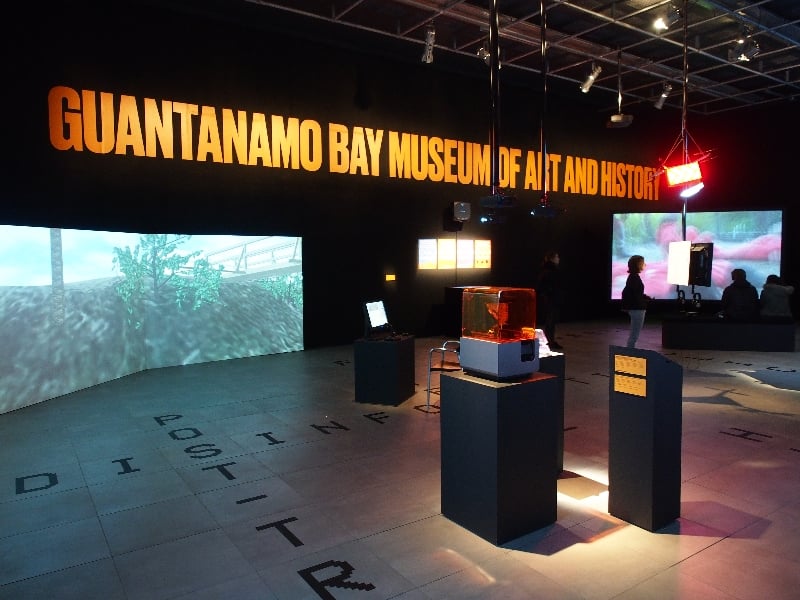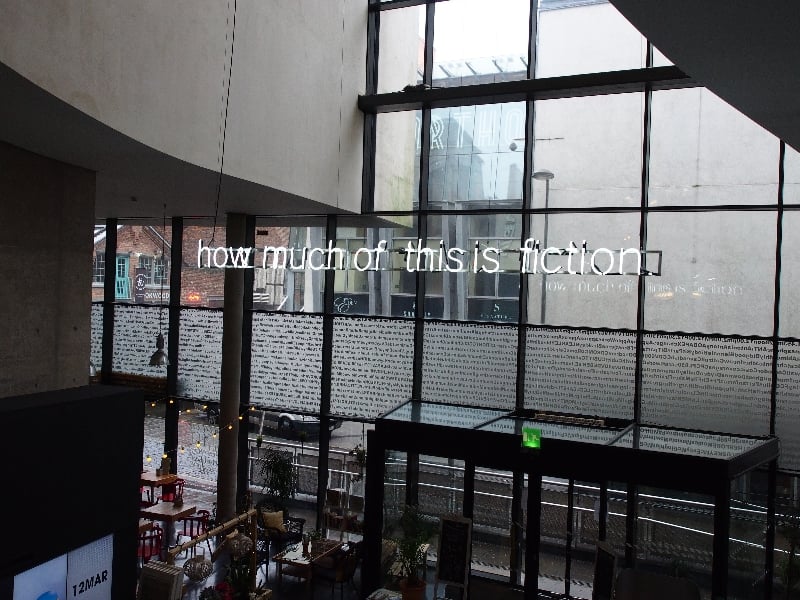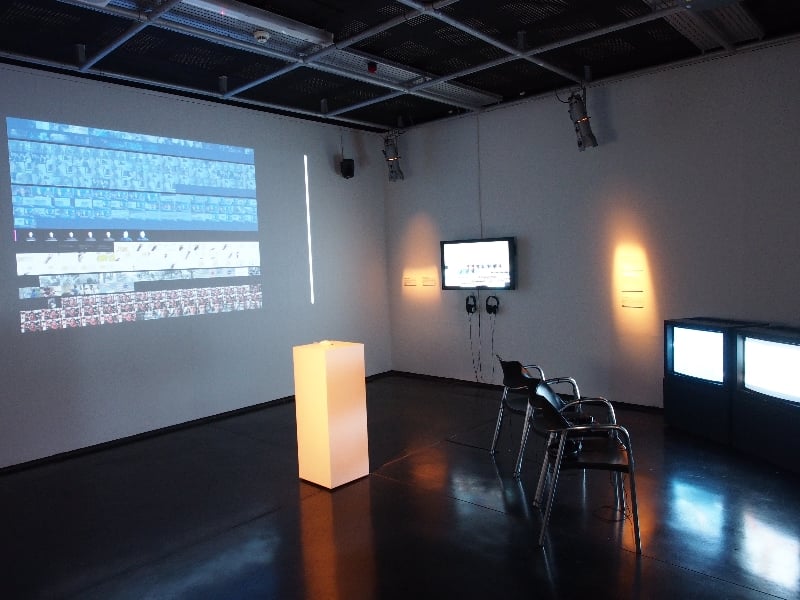
Photo: Steve Lamb Artworks. From left: Ian Alan Paul, Guantanamo Bay Museum of Art and History, 2012-ongoing; Coco Fusco, Operation Atropos, 2006
Occasionally, artists and curators will create an exhibition which will subsequently prove to be so prescient as to defy probability. Last year’s election of Donald Trump (presumably long after this exhibition was devised and integrated into FACT’s programme) has exacerbated an already cynical attitude towards the media. His protestations of ‘fake news’ and bizarre midnight Twitter frenzies mean that we now have a surreal melting pot of top level politics, social networks, conspiracy theories, and media manipulation.
For their exhibition How Much of this is Fiction, curators David Garcia and Annet Dekker bring together a plethora of contemporary multimedia artists, among them !Mediengruppe Bitnick, Moreshin Allahyari, The Yes Men, Wachter & Judd, Arabian Street Artists, and Ubermorgen. As part of the tactical media movement, the new wave of artists shown here have sought to use political awareness and technological prowess to infiltrate, subvert, and democratise the digital and broadcast media’s ownership of the ‘truth’. Rooted in the late 1990s, tactical media artists worked within the booming digital realm and its flourishing of technologists, commentators, and activists. Not only were concepts of media drastically broadening but there was a burgeoning cynicism in its official output. Artists working across these new-media platforms have continued to disrupt the conventional production and dissemination of information and this exhibition effectively shows a diverse range of artistic responses to the post-truth world.

Photo: Steve Lamb Artwork. Maia Gusberti, How much of this is fiction, 2014-ongoing
There are a wide range of artworks making How Much of this is Fiction a truly multi-media and contemporary experience, as one would expect in FACT. The first exhibit the viewer will encounter is ‘Assange’s Room’, which is a life-sized reproduction of his living quarters at the Ecuadorian embassy—the viewer’s ability to enter and leave at will stands in stark contrast to Assange’s own restrictions. Venturing into the dark Gallery One the satire is turned up a notch and varied artworks are exhibited under the umbrella of the ‘Guantanamo Bay Museum of Art and History’—an imagined museum dedicated to this enduring prison weirdly immune to normal laws of detention. ‘Zone*Interdite’ is a virtual reality walkthrough of Guantanamo Bay, presented on a large panoramic screen. With the purpose of facilitating exploration of hidden locations outside of their portrayal by broadcast news, it certainly provoked this viewer to consider how the technology would have been used had it been available in the 1940s—would Auschwitz have been a suitable subject matter? And would the technological novelty of navigating that virtual world potentially usurp its dreadful historical meaning? That is not a criticism, however, simply a recognition that multi-media exhibitions may not be (even in 2017) sufficiently widespread for the public to focus on message over medium. FACT is certainly playing a positive role here.
Upstairs in Gallery Two is ‘Torture Classics’, macabrely bringing together the Guantanamo theme with a parody of advertising and consumerism. An ironically innocuous ‘infomercial’ is shown for a non-existent compilation album of ditties actually misappropriated to terrorise prisoners within ‘enhanced interrogation’ at Guantanamo. This dark-humoured reviewer felt not a small amount of amused discomfort here, especially when remembering those real and infuriatingly long adverts on late night TV at the turn of the millennium. The ‘Newsroom’ section of Gallery Two is dedicated to real examples of how artists have invaded the digital and broadcast media to expose its exclusivity and bias. ‘Dow Does the Right Thing’ shows The Yes Men’s excruciating prank on the Dow Chemical Company 20 years after the Bhopal Catastrophe for which it was responsible. This works on many levels, not least in portraying a parallel universe where corporations actually care about the damage they do. Funny? Undoubtedly. It is also a call to arms and instructive in how these corporate behemoths can be so easily disrupted.

Photo: Steve Lamb Artwork. From left: Robert Ochshorn, Tactical Recollections, 2017
How Much of This is Fiction is an ambitious exhibition with a diversity of artworks, both in terms of medium (a 3D printer, videos, websites, interactive navigational software, marketing materials, and posters) and subject matter. It is challenging for the viewer, who should be aware that digesting it all will take time. There is however, no shortage of supporting information available in the galleries. Also worth bearing in mind is co-curator David Garcia’s statement that part of his selection process involved focussing on the artist as ‘trickster’—this does help to unite the exhibits as well as aid the viewer’s holistic experience of the exhibition.
As a timely reflection on artistic responses to media manipulation and post-truth How Much of this is Fiction is a success. It is enjoyable, engaging, thought provoking, cynical, and dark. For those interested in the modern media specifically and contemporary culture in general it is highly recommended. For those motivated by global politics and the capacity of art to defy, How Much of this is Fiction is essential.
Filed under: Art & Photography, Politics
Tagged with: art, FACT Liverpool, How Much of this is fiction, liverpool, politics, post-truth



Comments